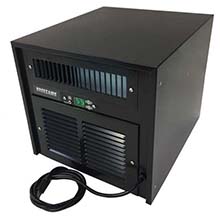To learn everything there is to know about wine cellar cooling units, visit our Wine Cellar Cooling Units Ultimate Guide.
Thermodynamics and stratification in your wine cellar

Most people are familiar with the idea that warm air rises and cooler air sinks. We don't usually think about the implications this has when cooling (or heating) a room. A closed space will always warm from the top down and cool from the bottom up, creating a stratification--layers--of temperatures. The ceiling area will always be warmer than near the floor. When you are dealing with a wine cellar, most of the heat is coming in from the walls, ceiling, floor and any doors or windows. Warmed air molecules rise towards the ceiling and form a layer of warm air which fills the room from the top down as more and more air warms up.
How does a Breezaire cooling unit maintain a stable temperature?
This phenomenon can be used in your wine cellar to create greater cooling efficiency. The lower, cooler area does not fluctuate much in temperature. It remains fairly stable while the area near the ceiling warms. Breezaire cooling units have a temperature sensor behind the return air grille, so when mounted near the ceiling the sensor will detect the warm air layer as it reaches the level of the bottom of the cooling unit, above the level of your wine. When this occurs, the Breezaire cooling unit will switch on and draw air from the warm upper portion of the room, cool it and send it back out. This pushes the level of cool air upward again. When the sensor in the Brezaire cooling unit detects that the appropriate temperature has been reached, the unit will shut off until the warm layer pushes down to the sensor again. All the cooling actions take place at the "stratification layer", the point at which the cool air meets warm, so the conditions in the lower area remain very stable. Stable, cool temperatures are one of the most important factors for wine storage and aging, and Breezaire cooling units are ideally designed for the purpose.
Relative Humidity
This is a fairly complex subject and is based on the study of psychometrics. While the word may be fun to say, the topic is a real headache. In short, relative humidity is calculated from a fraction, where the numerator is the amount of moisture in the air and the denominator is the maximum amount of moisture the air is capable of holding at its current temperature. This fraction is divided and multiplied by 100 to give the answer as a percentage. For a given amount of absolute moisture in the air the relative humidity will vary according to the temperature. The warmer the air the lower the relative humidity As a simple way to illustrate this phenomena imagine a clear, sealed box. Inside the box is a thermometer and a hygrometer (a device to measure relative humidity). When the box is sealed the thermometer reads 75° F and the hygrometer reads 50%. Now, place the box in a large walk-in refrigerator. (Remember that it's sealed, no air or moisture can leave or enter the box.) As the temperature begins to drop the relative humidity will rise. When the temperature reaches 55° F the relative humidity will be 100% and the box will begin to fog up as moisture condenses on the walls. This is because colder air cannot hold as much moisture as warm air; therefore, the bottom of the fraction has become smaller and the percent relative humidity goes up. If the box is removed from the refrigerator and allowed to return to 75° F the moisture will re-evaporate and the relative humidity will return to 50%. Air conditioners and refrigeration units are designed to chill the air to a very low temperature as it passes through the unit. This removes as much moisture as possible for the comfort of people or the prevention of ice formation. If these systems were used in a well-sealed enclosure the relative humidity would be reduced to an extremely low level, very bad for wine.
Breezaire cooling units are designed to chill the air only enough to remove the excess moisture, leaving enough moisture to keep the wine healthy. In the wine cellar, desired conditions are generally around 55° F and 50% to 75% relative humidity. If the cellar is closed and the cooling unit is originally turned on when conditions are at 75°F and 50% relative humidity it will be necessary to not only cool the cellar but to remove some moisture. If moisture were not removed the relative humidity would reach 100%, mold and mildew would form on the bottles and walls and labels would fall off. Additionally, if warm moist air infiltrates into the cellar, the excess moisture must be removed or the relative humidity will rise to unacceptable levels. The cooling unit will be overworked and the excess water could overflow from the unit, making a mess.
All BREEZAIRE cooling systems are specialized designs that create the kind of carefully controlled environment demanded by products that are highly sensitive to changes in temperature and humidity. They are not intended for use in standard refrigeration applications. For assistance in specifying the best system for your unique requirements and in creating the ideal storage environment, contact us and a wine cooling unit expert will be glad to help.
If you want to learn all about wine cellar cooling units, click to our Wine Cellar Cooling Units Ultimate Guide.


